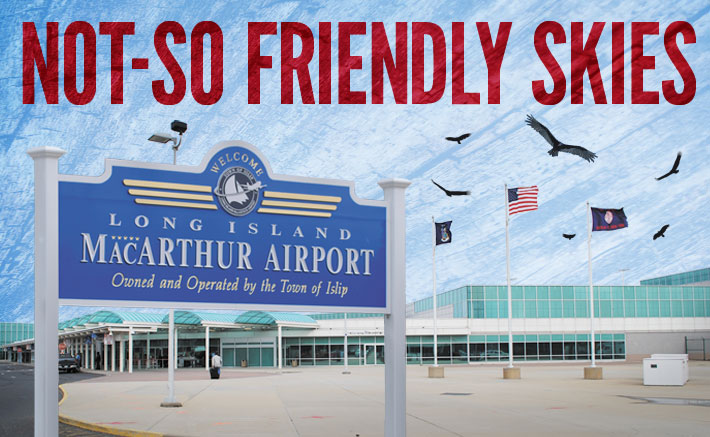
Try and Catch the Wind
More than 334,000 people live in Islip but only 49,709 of them cast their ballots last November, and Croci beat Nolan by 343 votes. It was an upset that rocked Long Island’s political world: an incumbent unseated by a newcomer.
Croci, a Lieutenant Commander now with the U.S. Naval Reserve, has been deployed twice to Afghanistan with a Navy SEAL team and served as deputy executive secretary of the Homeland Security Council for two presidents. He got his start in politics as a college intern working for Rick Lazio when he was the Republican congressman representing the district. The election also gave him a town board with no opposition: four Republicans (including Croci) and a Conservative.
Nolan’s victory in 2006 had made him the first Democratic supervisor in 40 years, so to many observers his defeat last November simply meant that Islip was reverting to its normal, Republican ways. But according to a December report, registered Democrats now outnumber Republicans by 2,000 people: 63,000 Democrats, 61,000 Republicans and 43,000 “blanks.” Regardless of the numbers, only a little more than 27 percent of these registered voters bothered to show up at the polls last fall.
Nolan had first come to the supervisor’s office in 2006, winning a special election after bribery and campaign fraud scandals forced out Republican Supervisor Pete McGowan in his 14th year in office. McGowan had been instrumental in bringing Southwest Airlines to MacArthur, putting the airport on the map by all accounts, and subsequently getting the new concourse named after himself. McGowan later admitted to Suffolk County District Attorney Tom Spota that he’d used more than $30,000 from his campaign to pay for expensive restaurants, spa treatments and massages as well as take vacation trips to Ireland and Florida, and he’d laundered $52,000 in kickbacks through his campaign account.
McGowan wasn’t the first Islip elected official to ever get into trouble with scandal. The airport, which began as a military facility in World War II and was later renamed after Gen. Douglas MacArthur, ensnared town leaders in the 1960s, particularly town attorney Walter Conlon. Even Newsday’s then-Suffolk editor, Kirk Price, was “buying some tax land up around MacArthur Airport,” and he was “involved in land deals with the Republicans,” as detailed in Robert Keeler’s Newsday: A Candid History of the Respectable Tabloid. Price had no interest in pursuing that story, and it languished until the paper’s legendary investigative reporter Bob Greene looked into it. Price and his wife had invested “only a $50 binder in a choice piece of airport property and later made a profit of $33,000 when they and their partners sold the land to a syndicate that included [town councilman Donald] Kuss,” wrote Keeler.
Those days of looser ethics for journalists and lawmakers are hopefully long gone—at least on Long Island. But the last thing the airport needs today is a hint of political scandal, which is why the recent change in town leadership and its potential impact on airport management has drawn such wide interest around the Island.
MacArthur Airport’s potential to rejuvenate the region’s economy is seen as key. According to several recent studies, MacArthur Airport generates some 6,085 jobs in the surrounding community (1,200 people employed at the facility) and $577 million in annual economic activity, at least in 2010. Maintaining the facility is a constant demand. Modernizing it is a necessity.
In 2005, the airport’s freshly poured concrete apron, which covers gates five through eight where planes park next to the concourse, had to be repaired because its six-inch base apparently wasn’t thick enough to resist the frost cycle and was starting to crack. Airport officials worried that debris collecting in the cracks could get sucked into the jet engines, creating a dangerous situation. That problem has since been fixed. The airport also boasts a two-year-old control tower.
Currently underway at MacArthur Airport are two improvement projects funded from passenger fees collected by the airport: One is a better terminal access roadway for $7.2 million; the other is a new drop-off canopy and vehicle inspection canopy for $2.7 million. Just last week it was announced that Dunkin’ Donuts has signed a 20-year lease to open up space left vacant by T.G.I. Friday’s restaurant. But the news people are waiting for—that a new airline is coming to the concourse—is still just pie in the sky. In January, JetBlue’s president and chief executive officer, David Barger, toured the facility with Commissioner Rizzuto, Supervisor Croci and Sen. Charles Schumer (D-NY).
“We continue to make the case to JetBlue that MacArthur has much to offer and we’re hopeful that JetBlue will decide that Islip is the right fit for their northeastern expansion,” Schumer tells the Press in a statement. “Currently, Long Island’s population is greater than 19 states and the infrastructure in Islip is already in place. MacArthur, already an important component of Long Island’s economy, has the capability of being a jobs juggernaut for the region, particularly if it is able to tap into the full potential of the passenger market that the Island has to offer.”
Several months ago US Airways announced it was reinstating two daily round-trip flights to Ronald Reagan Washington National Airport. The new flights start March 25. Air Canada and Ireland’s Ryanair have also been reported sniffing around Islip to see which way the wind is blowing.
“I know for a fact that the airport commissioner is entertaining quite a few airlines right now,” says Joseph Loccisano, president of Long Island Business Aviation. Which airlines they might be remain hush-hush for now.
“To come to a new place is a major, major decision,” says Nolan, who was in office when US Airways decided to increase its flights from MacArthur. “People could lose their careers over it if they get it wrong. They’re very hesitant. It’s a remarkably complex equation.”






